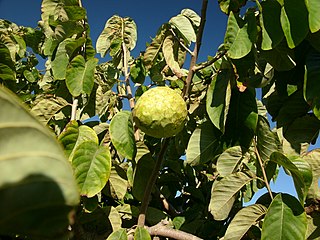
The cherimoya, also spelled chirimoya and called chirimuya by the Quechua people, is a species of edible fruit-bearing plant in the genus Annona, from the family Annonaceae, which includes the closely related sweetsop and soursop. The plant has long been believed to be native to Ecuador and Peru, with cultivation practised in the Andes and Central America, although a recent hypothesis postulates Central America as the origin instead, because many of the plant's wild relatives occur in this area.

Alectryon excelsus, commonly known as tītoki, or sometimes New Zealand oak, is a shiny-leaved tree native to New Zealand. It is in the family Sapindaceae. It lives in coastal and lowland forests throughout most of the North Island and from Banks Peninsula to central Westland in the South Island.

Parkinsonia aculeata is a species of perennial flowering tree in the pea family, Fabaceae. Common names include palo verde, Mexican palo verde, Parkinsonia, Jerusalem thorn, jelly bean tree, palo de rayo, and retama.

Inga feuilleei, commonly known as pacay or ice-cream bean tree, is a tree in the family Fabaceae native to Andean valleys of northwestern South America. Pacay trees, as is the case with other trees in genus Inga, produce pods that contain an edible white pulp and have nitrogen-fixing roots.

Cardamine hirsuta, commonly called hairy bittercress, is an annual or biennial species of plant in the family Brassicaceae, and is edible as a salad green. It is common in moist areas around the world.
Newtonia paucijuga is a species of flowering plant in the family Fabaceae. It is found in Kenya and Tanzania.
This page provides a glossary of plant morphology. Botanists and other biologists who study plant morphology use a number of different terms to classify and identify plant organs and parts that can be observed using no more than a handheld magnifying lens. This page provides help in understanding the numerous other pages describing plants by their various taxa. The accompanying page—Plant morphology—provides an overview of the science of the external form of plants. There is also an alphabetical list: Glossary of botanical terms. In contrast, this page deals with botanical terms in a systematic manner, with some illustrations, and organized by plant anatomy and function in plant physiology.
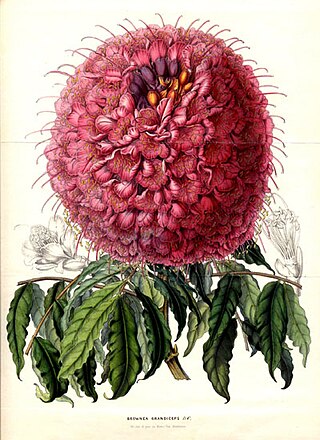
Brownea grandiceps is a species of tree in the family Fabaceae. Its common names include the rose of Venezuela and the scarlet flame bean. It originated in South America but is now widely grown as a decorative tree in tropical gardens.

Senna didymobotrya is a species of flowering plant in the legume family known by the common names African senna, popcorn senna, candelabra tree, and peanut butter cassia. It is native to Africa, where it can be found across the continent in several types of habitats.

Moringa stenopetala, commonly known as the African Moringa or cabbage tree, is a deciduous tree in the plant genus Moringa, native to Kenya and Ethiopia. A drought-resistant species, it is characterized by its bottle-shaped trunk, long twisted seed pods, and edible leaves likened to cabbage, from which its common name is derived. M. stenopetala is extirpated in the wild in Ethiopia, though still grown there as a crop on the terraces of the Ethiopian Highlands, mainly in the Konso region.

Mimetes fimbriifolius, also called cowl pagoda or the fringed pagoda, is a species of plant in the family Proteaceae. It is a dense, rounded, multi-branched tree that grows up to 4 metres in height. This attractive and striking plant flowers all year round, and produces red and yellow branch-heads and inflorescences. The nectar-rich flowers are pollinated by sunbirds and the seeds are distributed and taken underground by ants before germinating. It is endemic to the Table Mountain range in the city of Cape Town, South Africa.
Zanha golungensis, commonly known as the smooth-fruited zanha, is a species of plant in the family Sapindaceae that is native to Africa. It is used locally for timber and herbal medicine.

Cupaniopsis wadsworthii, sometimes commonly named duckfoot, or dwarf tuckeroo, is a species of flowering plant in the soapberry family and is endemic to Queensland. It is a slender shrub or small tree with paripinnate leaves with two to eight broadly wedge-shaped or broadly lobed leaflets, and separate male and female flowers arranged in raceme-like thyrses, the fruit a capsule with a seed with an orange aril.

Parinari excelsa, the Guinea plum, is a species of large, evergreen tree in the family Chrysobalanaceae. It has a very wide distribution in tropical Africa and the Americas. This species grows to 50 m (160 ft) tall while the trunk is up to 1.5 m (5 ft) in diameter.
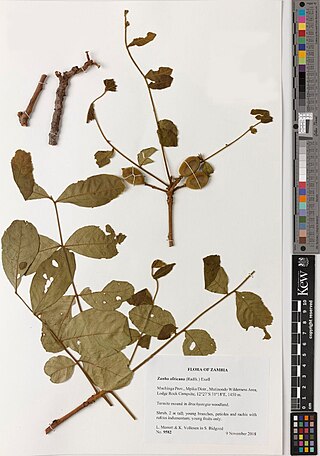
Zanha africana, commonly known as the velvet-fruited zanha in English and as mkalya or mkwanga in Swahili, is a species of plant in the family Sapindaceae that is native to Africa. It is used locally for timber and herbal medicine.
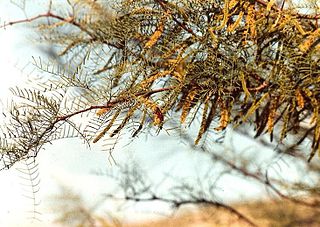
Prosopis chilensis is a species of tree in the genus Prosopis, belonging to the family Fabaceae. It is found in parts of central Chile, southern Peru, Bolivia, and Andean (northwestern) Argentina. Its common names include Chilean mesquite, cupesí, and Chilean algarrobo. It is used for providing shade, for animal feed, and firewood.
Mitrephora pallens is a species of plant in the family Annonaceae. It is native to Vietnam. Suzanne Jovet-Ast, the French botanist who first formally described the species, named it after its pale flowers.
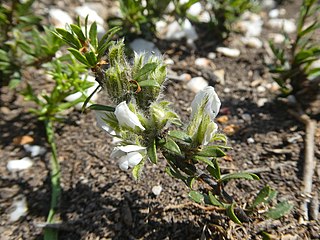
Otholobium curtisiae is a small spreading shrub assigned to the Pea family. All green parts are covered in hairs and urn-like glands. It has many woody stems, small and somewhat succulent, dark green alternately set clover-like leaves and heads consisting of 3-9 white, pea-like flowers on very short peduncles in the axils of the leaves. This species is an endemic of the Overberg area in the Western Cape province of South Africa. It mostly flowers in August and September.

Otholobium lanceolatum is a small subshrub of up to 20 cm (7.9 in) high, that is assigned to the Pea family. It has up to 7 horizontal stems with raised tips, few hairless, alternately set leaves with only one leaflet and clusters of 15-27 white, pea-like flowers with a purple tip near the top of the short, seasonal shoots. It is endemic to one site near Caledon, South Africa. Flowers only appear in November and December within one year after a fire destroyed the vegetation.
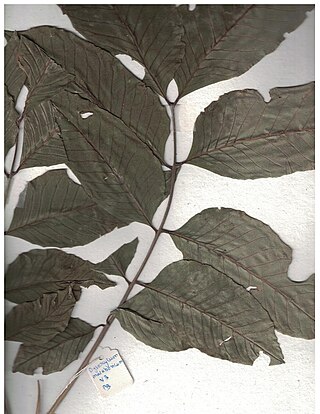
Dysoxylum malabaricum, or white cedar, is a tree species endemic to the Western Ghats, India. The species is considered Endangered under the IUCN Red List of Threatened Species.
















